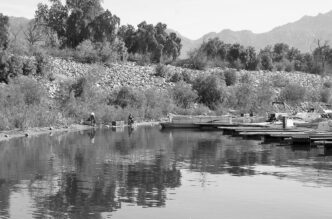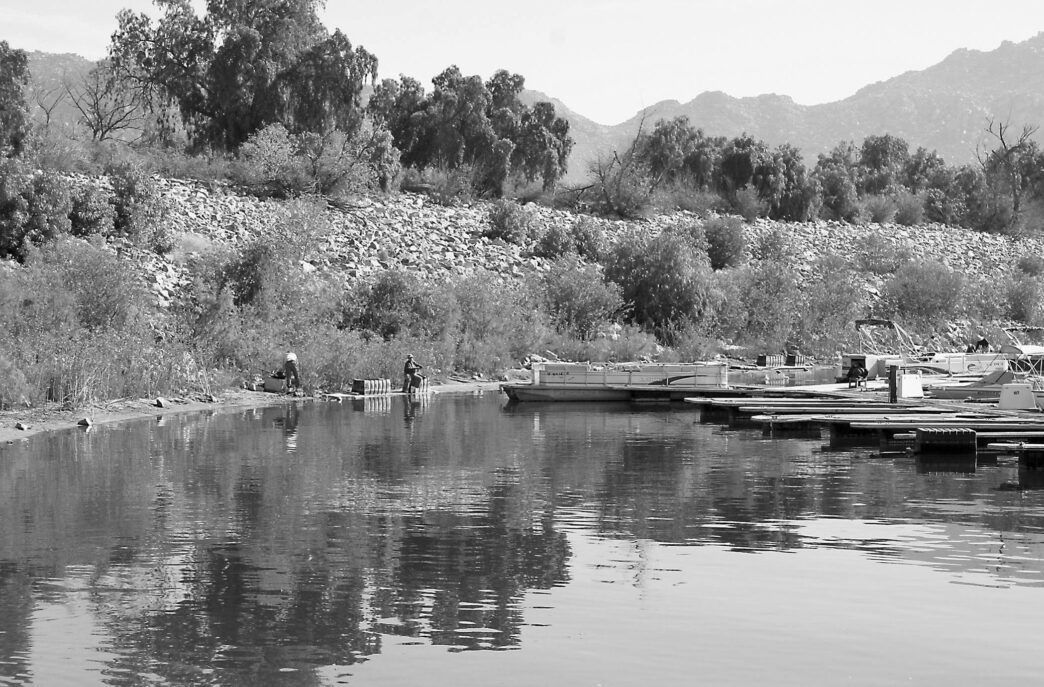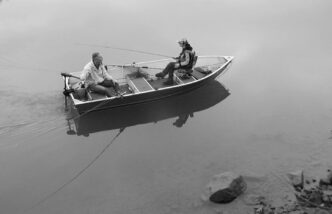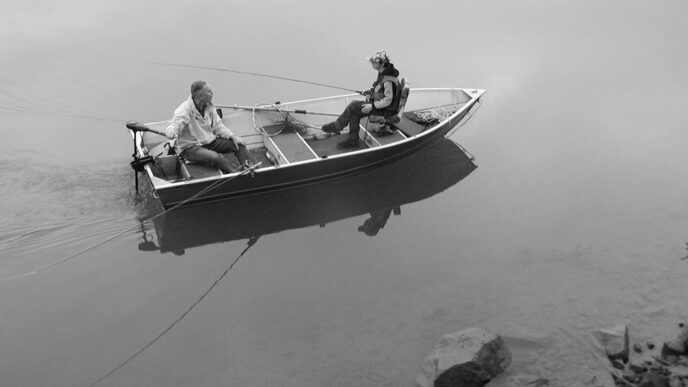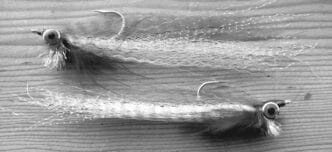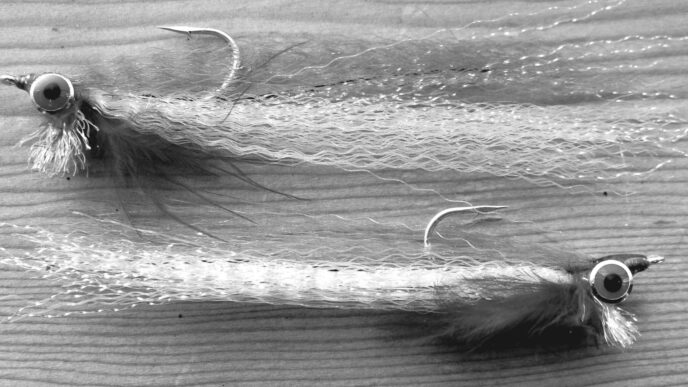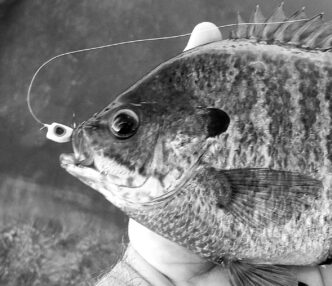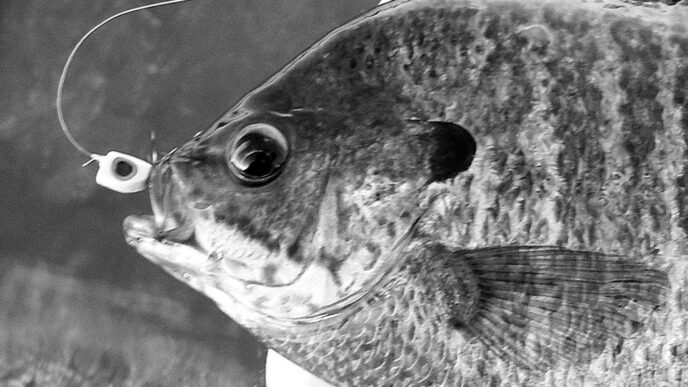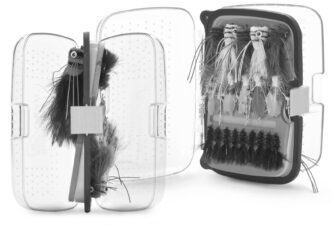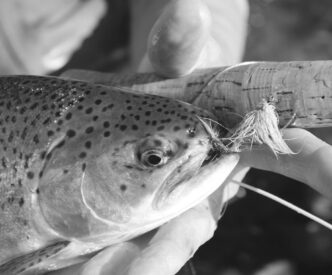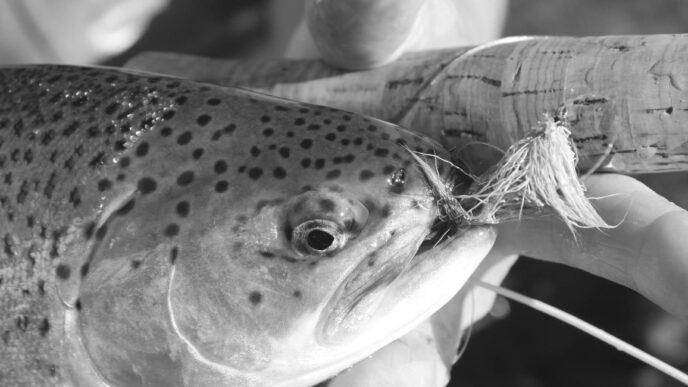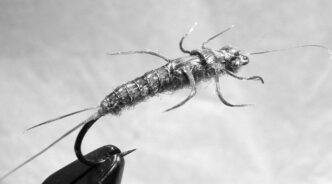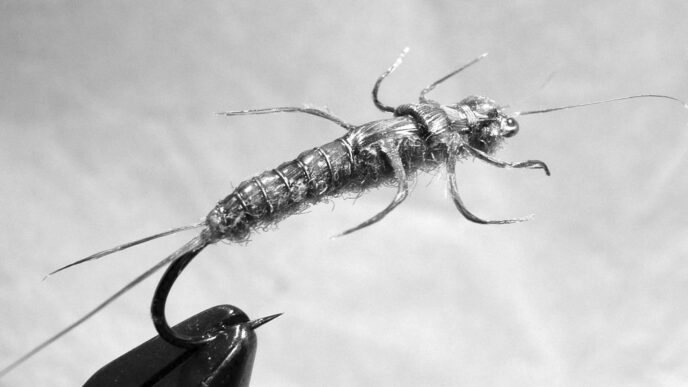One of my favorite spring rituals is going after bluegills and other panfish once the weather warms enough to bring them up shallow and in close to the bank. The fun starts as early as March and extends right through the summer months in most waters in California. Since just about every lake at low to modest elevations — and even some at altitude — have bluegills and other panfish, you don’t have to spend much energy seeking them out and can just enjoy the fishing. There are any number of places where you can catch large bluegills, and for fly anglers in the Southern California region, Lake Perris in Riverside County is one of them.
Prior to 2005, Lake Perris — at full pool — was a California Water Project reservoir of some 2,400 surface acres. An overhead look, such as you get on Google Earth, shows it to be basically a triangular impoundment. Anglers must share space with swimmers, water-skiers, and jet-ski enthusiasts. It can be a real chore to fish in the summer, and the lake requires reservations for boat launches on winter weekends and seven days a week from Memorial Day to Labor Day.
The reason I mention 2005 is that was the year the dam at the southwest end of the lake was discovered to have been poorly designed and unable to withstand earthquakes. A large fault near that end of the reservoir might cause the dam to collapse if it produces a severe earthquake. To reduce the likelihood that this might happen, the state lowered the lake’s level approximately 27 feet to take pressure off the dam until it can be strengthened.
The Fishery
Despite the drawdown, the angling at Lake Perris has continued to be good, particularly for largemouth bass and panfish. The panfish population at Perris has been excellent for many years. Perris produces prodigious bluegills with a lake record of several pounds (yes, pounds) and redear sunfish that get even bigger. I asked the Department of Fish and Game’s Region 6 senior fisheries biologist, Mike Giusti, if he thinks, as had been suggested by some anglers, that bluegills and redear sunfish are hybridizing in Lake Perris. He said no, he’d seen no evidence to date, but it can happen. At any rate, the bluegills in Lake Perris attain very large size, as do the redear sunfish. There is also a modest number of crappies in Lake Perris and the remnants of what used to be a prolific green sunfish population.
In addition to the warmwater fishery, trout are stocked in the lake during the cooler months of the year. When Perris was at normal depth, there used to be large numbers of trout that were able to hold over throughout the year, and canny oldtimers would catch fine trout out by the dam, even in the middle of the summer.
Since the draw-down of the lake, this fishery seems to be more of a winter event.
Make no mistake: Despite the drawdown, the panfish action at Lake Perris is of high quality. I know anglers who keep boats moored at the marina and fish it every day during the spring. Perris is not a deep lake, and before the water level was lowered, there were some great areas on the north side of Alessandro Island that held heavy concentrations of redears and bluegills. I once spent a morning with some other interested bass and panfish anglers sweeping the area with one of those underwater TV camera systems. I saw bluegills and redears that dwarfed even the big ones we had been catching all spring.
In some parts of the South, redears are known as “shellcrackers” because they often feed almost exclusively on freshwater clams and mussels. I was told by Mike Giusti that the department is raising redears for stocking in a local lake as a biological test on the control of quagga mussels. Sections of the lower Colorado River with quagga mussel infestations have lower mussel populations where redears are abundant, so perhaps redear sunfish will become an important control measure in Southland waters, as well as adding to the recreational fishery. At this point, Lake Perris does not have quagga mussels, or if it does, perhaps the resident redear sunfish are already keeping them in check.
Flies and Tackle
Most of the panfish anglers that fish Lake Perris use lures, bait, or a combination of both. Redears, in particular, are often bottom oriented and are easier to catch using live crickets or wax worms fished right on the bottom. They will take a variety of baits, and I have caught a couple of whopper redears fishing a black cricket fly pattern on a sinking line in an area where other anglers were soaking live crickets. They will also hit a small (size 12) Woolly Bugger drifted very slowly across the bottom when they are bedding in the spring. I’ve caught a few on wet flies when they were hanging out under the boats moored in the marina at Perris.
Bluegills, on the other hand, feed throughout the water column, taking all sorts of baits and lures, and — most importantly — they are easy to catch on flies. The first thing that most fly anglers think of when they fish for bluegills is a small cork popping bug. Over the years, I have caught quite a number of large bluegills and even the odd redear sunfish or two on poppers. My friend Jim Matthews, a local outdoor writer, says “I like small poppers, size 8 or 10. Any color of popper will work for me. I am not one of those anglers who thinks color means a lot to bluegills.” I agree, but also believe yellow is a good color for bluegill poppers. Matthews has been experimenting with making bass and panfish poppers out of California buckeye, a strong work that is nearly balsa-like in weight. (See Jim Matthews’s feature article, “The Right Wood,” in this issue.) About all you need are miniature versions of Lefty’s Bug, a simple cork popper built on size 10 or 12 hump-shank popper hooks with just a suggestion of a tail (the original uses red squirrel tail) or a tiny amount of hackle fibers and one wrap of hackle as a collar. It isn’t the color that gets attention — it’s the movement. Bluegills and other panfish, especially in the spring, investigate anything that drops on the surface, and they are certainly suckers for anything that appears to be alive.
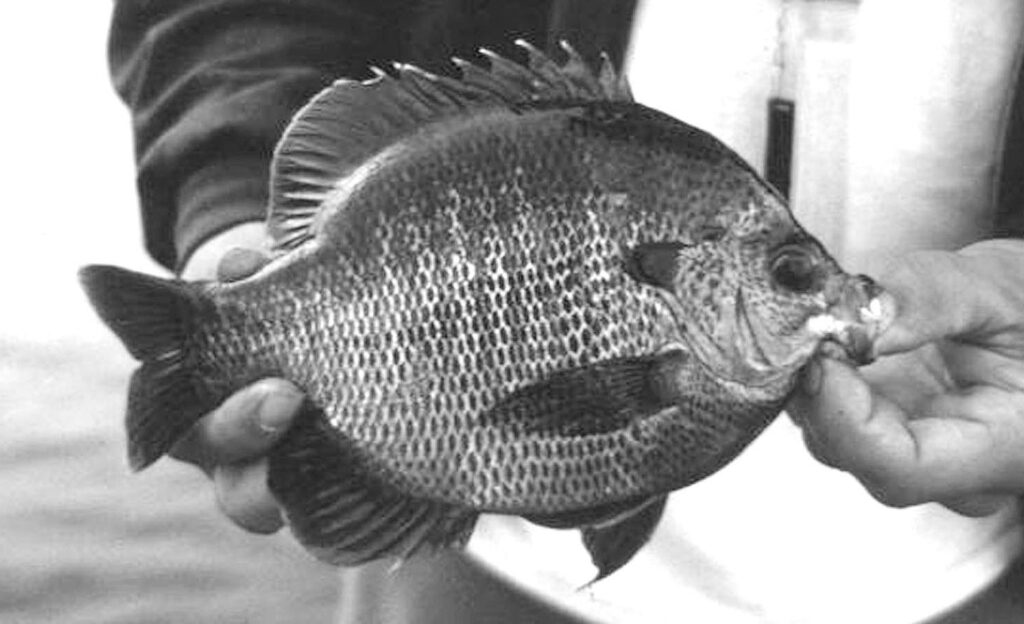
It isn’t necessary to do much popping when fishing for bluegills. The kind of action that draws bass often spooks bluegills, especially in shallow water. On the other hand, if you find them holding over deeper water, as they do around the marina docks or around the tops of submerged trees, you may have to pop the bug a time or two. This usually gets attention from a fat bluegill that rises up from the depths to hang like a tiny blimp just below the popper. Often, they’ll just sit there inspecting the popper until you twitch it again. Then they suck it down.
You can also catch all sizes of bluegills on dry flies. Anything that floats well and looks buggy will work. Over the years, I’ve depleted several fly boxes of worn-out or ragged Humpies, Trude patterns, Bivisibles, foam ants, and various terrestrial patterns that were beginning to come apart and weren’t suitable for trout fishing anymore. Bluegills will tear them up the rest of the way, but you can catch a bunch of fish before the fly disintegrates.
Sometimes you need a more delicate approach. Vince Novits, who works at a local tackle shop, says he has better luck when fishing the fly just under the surface around the marina docks at Lake Perris. “We fish a few inches below the surface with a fly I call a Maggot. It’s just some white yarn wrapped on a size 16 scud hook,” Novits reports. “They won’t take it on the surface, so I use some tungsten putty to get it down about three inches, and the fish fight to see which one gets it first.” A miniature San Juan Worm tied about an inch long works in the same way.
Bluegills and most panfish are also suckers for wet flies, and often the more bedraggled the fly, the better they like it. Just as with dry flies, I often clean out my trout boxes, using up all those wet flies that have seen better days. So if you plan on tying flies especially for bluegills, you needn’t be very fancy. One of my favorite wet flies for both small-stream trout and bluegills in lakes is the Brown Hackle Pea-cock. It’s about as simple a fly as you can find, quick to tie and easy to fish.
For some reason, bluegills like a combination of black and yellow. For years, I’ve tied simple versions of the Western Bee for pond fishing, and they work remarkably well everywhere I’ve fished.
Rods and lines for big bluegills and redears are pretty basic. Your trout gear is perfectly adequate. A 5-weight or 6-weight weight rod and line will do nicely. For fishing in the marina at Perris, where you want to be able to cast to the boats and docks from the shore, an 8-foot or 9-foot rod is a good idea, but I often prowl the banks on other parts of the lake with a 7-foot 5-weight.
For much of the fishing in the spring, you can just use a floating line, but if you want to access the deeper water in search of the biggest bluegills and redear sunfish, a full sinking line is wise. You could be fishing down as deep as 20 feet. This is especially true for float-tube and kick-boat anglers fishing the back end of the lake. Panfish are not particularly leader shy, so match the tippet to the size of fly or popper you are casting, and you’ll do fine.
The Water
It would probably be easier to show you those places where you won’t catch bluegills or green sunfish at Lake Perris than to highlight areas where you will. Actually, in the spring, bluegills spread out all along the shore at Perris, seeking shallow water to spawn. For the bank-walking or wading angler, the east side of Perris has a lot of gently sloping shore, and until the drawdown, there was plenty of brush along the shoreline. The Department of Fish and Game has done a considerable amount of work to offset the effect of the drawdown by installing man-made brush piles in many of the shallows. They’ve primarily used old citrus trees. Clumped together and weighted down, the trees create great habitat for invertebrates, tiny baitfish, and the young of all species of game fish, as well as attracting and holding bluegills and other panfish.
“Last year we put in 265 citrus tree habitats,” said Quinn Granfors, one of the Region 6 lake biologists. “We got a lot of root-balls, tree stumps, and large branches. We are basically going to duplicate the effort this year. All of those habitats went into the five-mile-per-hour zones. They are in 8 to 15 feet of water. We have good GPS positions on all these trees. We got a lot of stumps out of the old citrus orchard this year — they last a long time.”
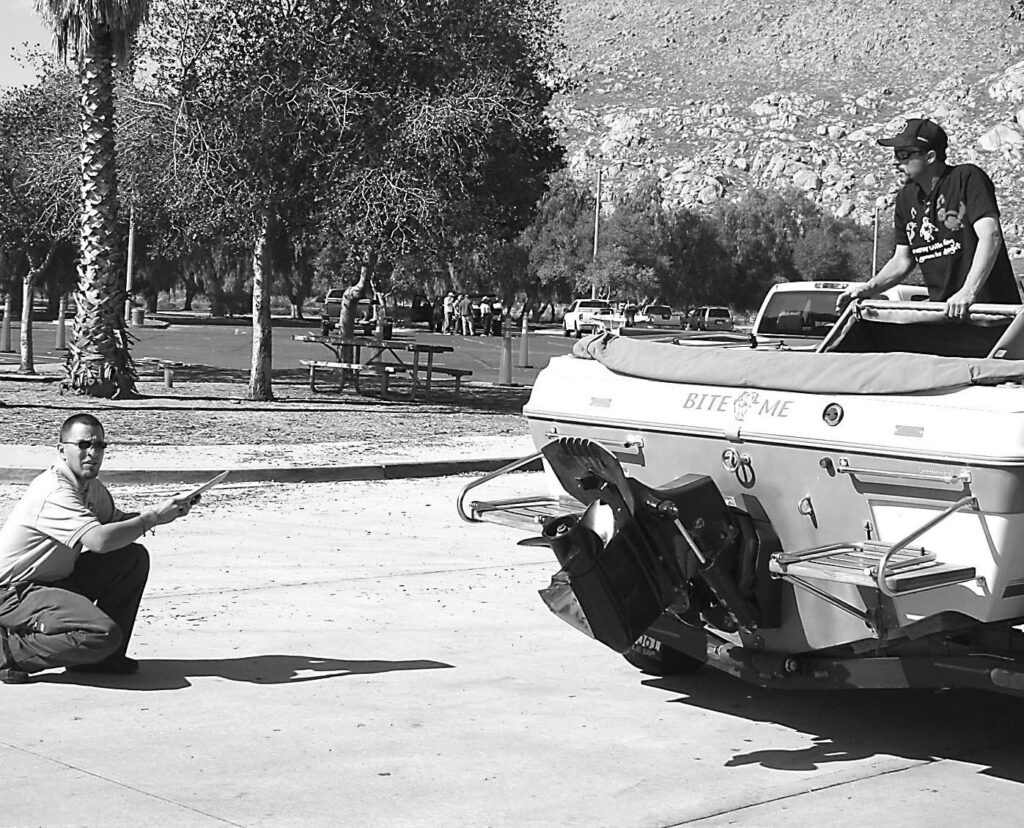
You access this part of the lake by driving east on Ramona Parkway until you hit Bernasconi Road, which is the entrance to the east side of the lake. There’s a parking lot with a picnic area and restrooms near the water and a good bicycle path that runs around the lake. As you face the water, Rockclimber’s Cove (where the rock for the dam was removed) is to your left, as is the east corner of the dam. To your right are the east and north sides of the lake. There’s a lot of shore to walk and fish, or you can launch a float tube there. (Don’t forget to check in with the quagga mussel inspection station at the main launch ramp on the other side of the lake first, though. Float tubes and kick boats are not specifically mentioned in the rules for quagga mussel inspections, but I suspect you will have to go though the inspection process.)
The shoreline on the west side of the lake is steeper, with heavy riprap along the edges, except for the swim beaches. The lower water level is just below much of this riprap, and there is a bit of a beach a few feet wide on which you can walk around the marina and the launch-ramp areas. The upper end of the lake is a lot smaller now that the water is down, but the park staff moved the five-mile-per-hour buoy line out on the “front” side of Alessandro Island, so the remaining water in the shallow end is devoid of fast boat traffic — nice for tube or kick-boat fishing. This area is good for all the species that inhabit Lake Perris, but it is particularly good for the largest redear sunfish, because they bed in deeper water and generally hang around in deeper water throughout the year.
If you don’t mind the walk, the riprap on the dam face also holds a lot of bluegills. There is a parking area down near the southern park entrance at the end of the dam, and you can also ride a bicycle along the dam and fish everywhere except the east end, where there is a buoyed-off area around the outtake towers.
If you like just plain fun with a fly rod, then you will appreciate the panfish action at Lake Perris. There’s something there for every angler, and you should put this water on your spring and summer destination list.
If You Go…
Lake Perris is located in Moreno Valley, near Riverside, some 70 miles east of Los Angeles and 80 miles north of San Diego. Part of the Lake Perris State Recreation Area, it has three entrances. The north and south gates are normally manned, and there’s an unmanned pay-envelope gate at Bernasconi Beach on the southeast side of the lake. From Los Angeles, take the Pomona Freeway (State Highway 60) to Moreno Beach Drive, then go south to the north entrance gate or turn south on Interstate 215 to the Ramona Expressway, then turn east. Its about 3 miles to the southern entrance from there.
At just under 1,600 feet in altitude and 2,370 surface acres when full (it’s just over half that size now), Perris is an ideal winter fishery, with a mild climate most of the year. However, it’s quite hot there during the summer and can be cold and frequently windy in the winter. Some mornings can be chilly, and thick fog is not unheard of.
The spring is a great period to locate and catch trophy-sized largemouths. Florida-strain and Florida-northern hybrids dominate the bass fishery. Floridastrain bluegills were stocked several years ago, and the lake regularly produces bluegills of two to two and a half pounds, with a few over the three-pound mark. Trout are stocked in the winter and provide fly anglers some action. In addition to the fantastic bluegill and redear sunfish population, in the last couple of years, crappies have been caught in fair numbers.
The lake is open year-round, with park hours from running from 6:00 A.M. to 8:00 P.M. in the winter and 6:00 A.M. to 10:00 P.M. in the summer. Camping is available for both tents and RVs and trailers, some with hook-ups. Check the Internet at http://www.reserveamerica.com for current prices. For additional information, call the Lake Perris State Recreation Area office at (951) 940-5600.
The day-use fee is $10.00 per car, and you can also purchase annual passes. Boat launching costs $8.00 per vessel — float tubes are not considered vessels. There is a full-service marina with boat rentals and excellent launch ramps. However, since the draw-down of the lake, only Launch Ramp 6, is now operational, but the park hopes to have the other ramp open this spring. There are also bait-and-tackle and snackbar facilities. Fly-tackle offerings at the lake are nonexistent, but fly tackle is available at Bob Marriott’s shop in Fullerton or the Bass Pro Shop in Rancho Cucamonga.
For information on current fishing conditions at Lake Perris, the phone number of the marina is (951) 657-2179. Fish-n-Map, 8535 West 79th Avenue, Arvada, CO 80005 has a topographic map for anglers that also includes Lake Skinner and Lake Silverwood.
Also, Lake Perris, like all Southern California reservoirs, is faced with the threat of quagga mussels, and there are ongoing inspection regulations for watercraft. The nuisance caused by this invasive species is going to be with recreational users of Southern California waters for many years, perhaps permanently, and you just have to get used to it.
Richard Alden Bean



